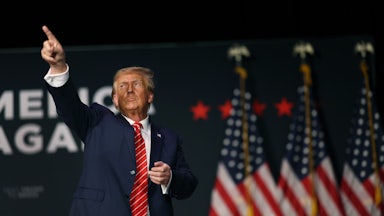Fellas, is it gay to be obsessed with another man’s feet? Once upon a time, the Republican base would have frowned at it, for sure. But over the past several months, Governor Ron DeSantis’s footwear has increasingly become an object of lurid attention on the internet. Stoked by DeSantis’s Trumpist foes, as well as by Donald Trump himself and his social media team, internet commenters and now some journalists want to know: Is Ron DeSantis wearing lifts in his cowboy boots?
While DeSantis denied the allegations in a recent interview and asserted that he is five-foot-11-inches tall, consulted boot experts—yes, I said boot experts—suspect he is lying. Some speculate his motive is to appear taller, based on a relatively thin gruel of evidence that taller candidates do better than shorter candidates in American politics. Whatever the underlying reality of DeSantis’s feet and height, the episode illustrates an unusual feature of Trump’s political rhetoric that has now transformed American politics.
As any invocation of boot experts should indicate, GOP politics is getting campy. Trump’s insults have long been infused with camp and, as he remakes the Republican Party in his own image, camp theatrics are consequently increasingly crucial to how we should understand GOP political strategy and messaging. Camp is an aesthetic of passionate and highly articulated exaggeration, an aesthetic that transforms the tacky, brash, and ironic into splendor through sheer fearless commitment. Camp is historically and quintessentially gay, but, dislodged from any tempering gay sociality, Trump’s camp is cruelly straight. Camp is when the irony is so thick and the bit so committed that it tips into seriousness. In Trumpism, camp may in fact be deadly serious.
Lifts or no lifts, DeSantis’s choice of footwear admits many ironies. Cowboy boots are an icon of Western American masculinity, a symbol of tall, rugged, stoic, and independent manhood. That image of authentic masculinity was, of course, invented over the course of the twentieth century by popular authors and Hollywood filmmakers. Contrary to whitewashed film Westerns, actual nineteenth- and early twentieth-century cowboys tended to be a diverse group, drawing heavily from formerly enslaved Black men as well as Hispanic and Native communities with long histories of skilled horsemanship. The boots themselves probably migrated north with vaqueros from Mexico, a journey that Trump and the contemporary GOP would build a wall to impede. While Hollywood cowboys may be exemplars of heterosexual masculinity, the actual living conditions on the Western range and ranch tended to facilitate same-sex intimacy and less rigid gender roles. Finally, while cattle ranchers as a group have been (and continue to be) vitriolically opposed to the federal government, the cattle industry is heavily dependent on the public purse, with sweetheart access to federal grazing lands and $38 billion in direct subsidies.
These ironies circle a more fundamental tension between the boots’ function and their fancy. What would become known as cowboy boots were originally a type of work boot uniquely suited to the labor of late nineteenth-century cattle management, a fact that explains their distinctive design elements. The deep and angled heel, flat sole, and slightly pointed toe of the traditional design make it easier for the wearer to mount a horse and safely fix their feet in stirrups. The flat square heel of modern “roper” designs is more appropriate for rodeo sports, where the wearer is expected to move easily on and off a mount. There are still an estimated half-million working horses in the United States today, and their riders still pull on cowboy boots for practical reasons. But as actual work boots, the boots of real cowboys lack the polished soft leather and aestheticized touches of the finer boots found on DeSantis’s feet. (DeSantis indicated his boots are “standard off-the-rack Lucchese boots.” Lucchese men’s traditional-style cowboy boots retail for anywhere between $500 to $16,000.)
It seems unlikely that DeSantis has spent much time in the saddle. There is nothing in his official campaign biography to indicate that DeSantis rode horses during his youth in Florida, his education at Yale and Harvard, his time as a U.S. Navy judge advocate general, or as an adult resident of Florida—although his wife, Casey DeSantis, is an accomplished equestrian. Florida has a modest population of beef cattle, but most residents are more likely to spend their time walking on boardwalks, concrete, and asphalt than in the saddle. In DeSantis’s case, one wonders how his boots’ flat soles fare on the smooth marble floors that line the halls of power. Boots that are functional for working cowboys may, in other contexts, read as impractical, ostentatious, and ornamental flourishes, a reminder not of the wearer’s proximity to the traditional working-class masculinity they are attempting to embody but their distance from it.
Such an aestheticized approach to adornment is what we pointy-headed intellectuals call “fashion,” and it is precisely what renders cowboy style such a durable source of camp and queer parody. Think here of Lil Nas X in “Old Town Road,” Orville Peck, or my personal favorite, Ssion. Or, for that matter, consider the frequency with which drag kings perform in cowboy boots. Wearing such practical boots for such impractical purposes doesn’t shore up an effortlessly authentic masculinity, it demonstrates its effortless inauthenticity; how easily it can be fabricated.
A snag in the fabric makes one, in the parlance of drag performance, easier to “read”—meaning to draw attention to a flaw in another drag performer’s appearance. It doesn’t take much of a tweak to cowboy boots, as one boot expert noted, to “turn them into five-inch stilettos,” an image Trump’s internet fans have embellished further with Photoshop. Most drag performers would be embarrassed if their lifts looked so obvious. Yes, sometimes drag performers accentuate the artifice of gender and make the seams of the outfit more obvious, but often drag performers also aim for “realness,” a term meant to convey the sense that a look is flawless enough that the performer could pass as the real item outside the context of the show or ball, surely what DeSantis’s boots, lifted or not, aim to accomplish. “Realness” comes in an endless variety of stylizations and genres—from prom queen to JAG military butch—that are simultaneously highly exaggerated and yet passionately embraced. If they can’t pass, queens (and kings) read contestants by pointing out the elements of the performance that fail to be real, where the inauthenticity is most apparent: when it’s busted, not camp.
Whatever else you can say about him, Donald Trump reads his Republican opponents. Good reads require an unusually flexible relationship to the truth. On the one hand, a good read is true: It grabs at a real thread, no matter how tiny, and it tugs it to unravel the whole outfit. On the other hand, good readers are acutely aware that it’s still all artifice all the way down, which means they don’t get bogged down with contradictions and inconsistencies. In the 2016 Republican primary, Trump memorably pilloried Jeb Bush as a failson, a guy who had only ascended to national prominence because of the notoriety of his father and brother and was now an “embarrassment to his family.” It effectively humiliated Bush because it tugged on an underlying truth about the dynastic vintage of his candidacy and the undeniable fact that his family connections were integral to his political success. And it didn’t matter that something similar could be (and has been) said about Trump’s successes. If anything, Trump’s disregard for consistency and fair play convinced voters of just how ruthlessly he would treat his enemies. In other words, what would otherwise be tacky behavior—what could be more unseemly than flagrant hypocrisy?—became the measure of his earnest commitment, the seriousness with which he would pursue his then-seemingly absurd candidacy.
The Trump campaign’s current read of DeSantis’s boots follows that pattern. The attraction of the cowboy boots line may relate to DeSantis’s physical height, but it also pulls on a deeper thread about DeSantis’s relative standing with prospective voters. Considering the ostensible purpose of the lifts is to make DeSantis seem taller, it fortifies the claim that DeSantis is trying (and failing) to stand as Trump’s equal, the case he must make to dethrone Trump. Some reporting has indicated Trump considered the idea of “Tiny D” as a derisive nickname for DeSantis—what would seem, at first glance, an odd choice to describe a man who is not, by most accounts, physically below average, much less tiny. (Eventual winner “Ron DeSanctimonious” is a rare nickname miss from Trump, by my assessment.) The point of all this talk about size and height is not really about DeSantis’s body—whether the nickname was referencing the whole of that body or merely a “tiny” part of it—so much as it is a way of figuratively describing the relative size of Trump and DeSantis as passionate objects for the GOP electorate: Trump is the big guy and DeSantis the puny wannabe chasing after him. “Lifts in his cowboy boots,” then, works as deft shorthand for the phony and flailing masculinist posturing DeSantis’s GOP antagonists see; DeSantis is all lifts and no stirrups.
But paying such close attention to the other guy’s very fancy shoes, to say nothing of the dimensions of his body, is, as the kids say, a bit sus and precisely what makes Trump’s insult camp. From a different candidate, an insinuation about DeSantis’s masculinity might read as desperate and tacky, proof of that candidate’s own banal masculine insecurity. But just like every one of Trump’s many personal vices, his blaring insecurity only endears him further to his voting base. What makes his approach to insults distinctive is that they are both hyperbolic and obviously hypocritical, a mixture that conveys a ruthlessness that is inseparable from hungering insecurity. How seriously does he take his exaggerations and hyperbole? He’s so serious about telling the truth, he’s willing to lie to do it. Could anything be more camp?
Queens and kings competing in a ball usually do so with a pleasure, good humor, and solidarity that comes from struggling and suffering together in an inhospitable world. Sure, sometimes a read is vicious and spiteful. Usually, however, reading is fair game, frequently affectionate, and always part of the process by which good drag performances make and unmake gender in real time for their audiences: Reading is partially about winning but partially about an earnest commitment to gender’s fragile unreality.
By contrast, Donald Trump is a man who appears to have an instinctive grasp for camp as an aesthetic, even as he lacks any leavening solidarity with the people he wants to humiliate. “There’s a tendency to look at Trump’s mannerisms—his fussiness, his love of musical theater—as somehow gay,” the novelist Jacob Bachrach noted to me over the phone when I asked him about a similar observation he once made on Twitter, “but he’s actually another familiar New York character: the straight queen, a practicing heterosexual who just happens to have very specific opinions about why that makeup looks terrible, Andrew Lloyd Weber, and women’s shoes.” There is undeniable sociological realism here. Trump’s social worlds before he entered politics—Manhattan high society, real estate, fashion, and television celebrity—are suffused with and even ruled by gay aesthetics (to say nothing of many affluent, white gay men), even as there is little evidence that Trump has any familiarity with the complex racially and class-mixed social worlds out of which camp aesthetics and drag emerged.
Common sense says Trump has been remaking the Republican Party in his own image both by encouraging imitators and by flogging dissenters. But when most commenters discuss this transformation, they focus on the party’s shift toward Trump-allied networks of influence, greater procedural radicalism, growing personal corruption, and, to a much lesser degree, his policy preferences. As the interest in Ron DeSantis’s boots and possible rises indicates, Trump is also remaking the GOP aesthetically. His supporters, probably unaware of the provenance of the aesthetic, have imbibed all the ugly cruelty of camp without reckoning with any of the shared human vulnerability that shadows and perfects it.










